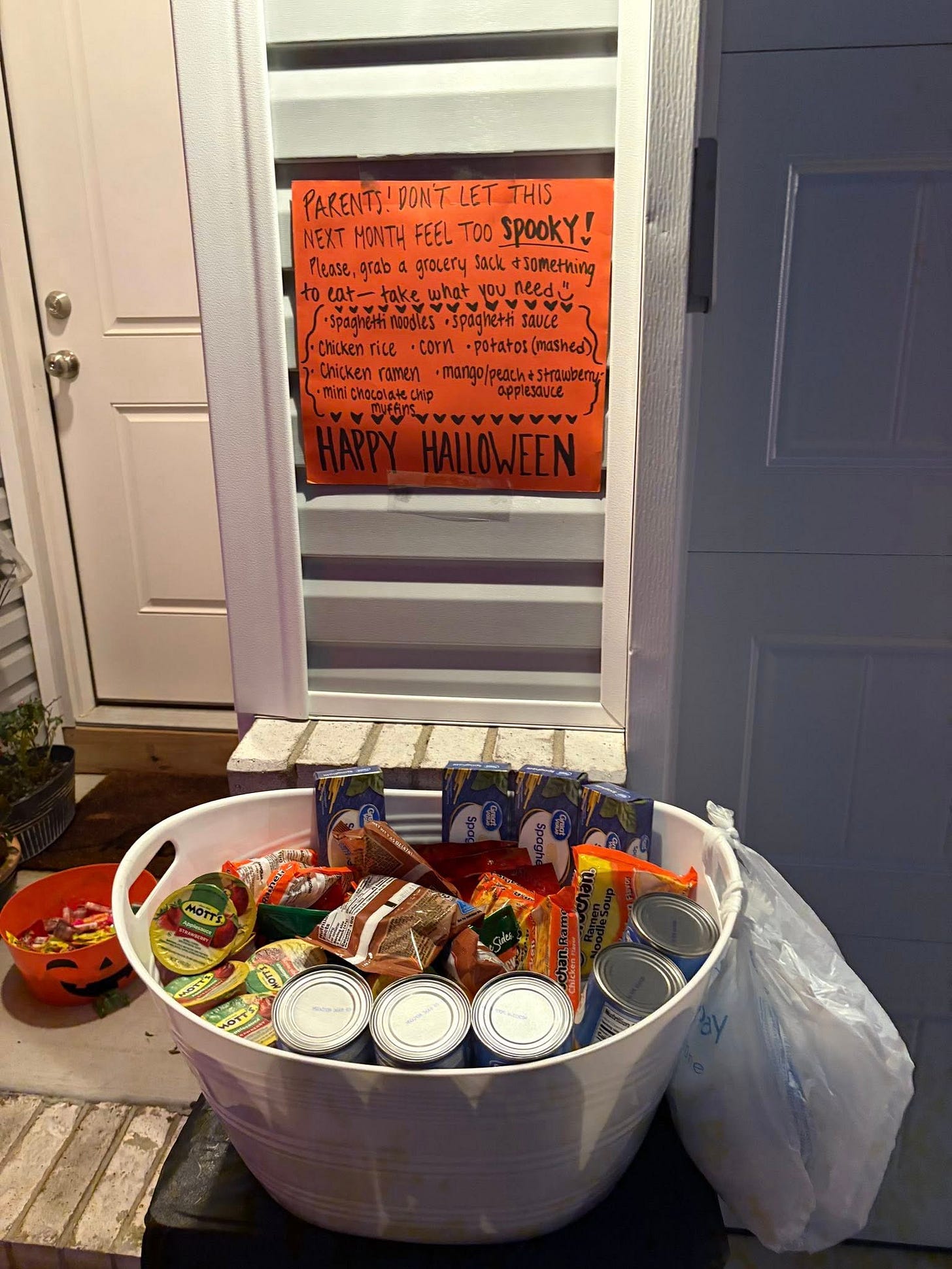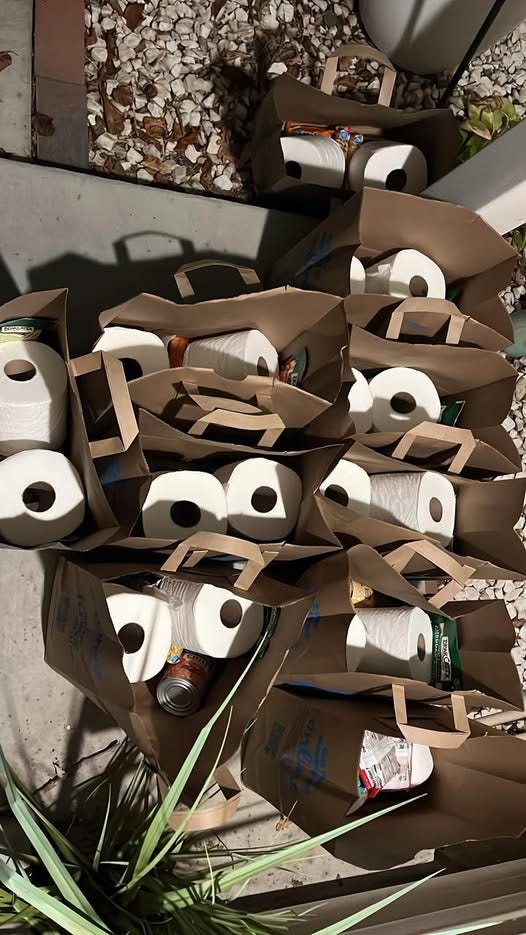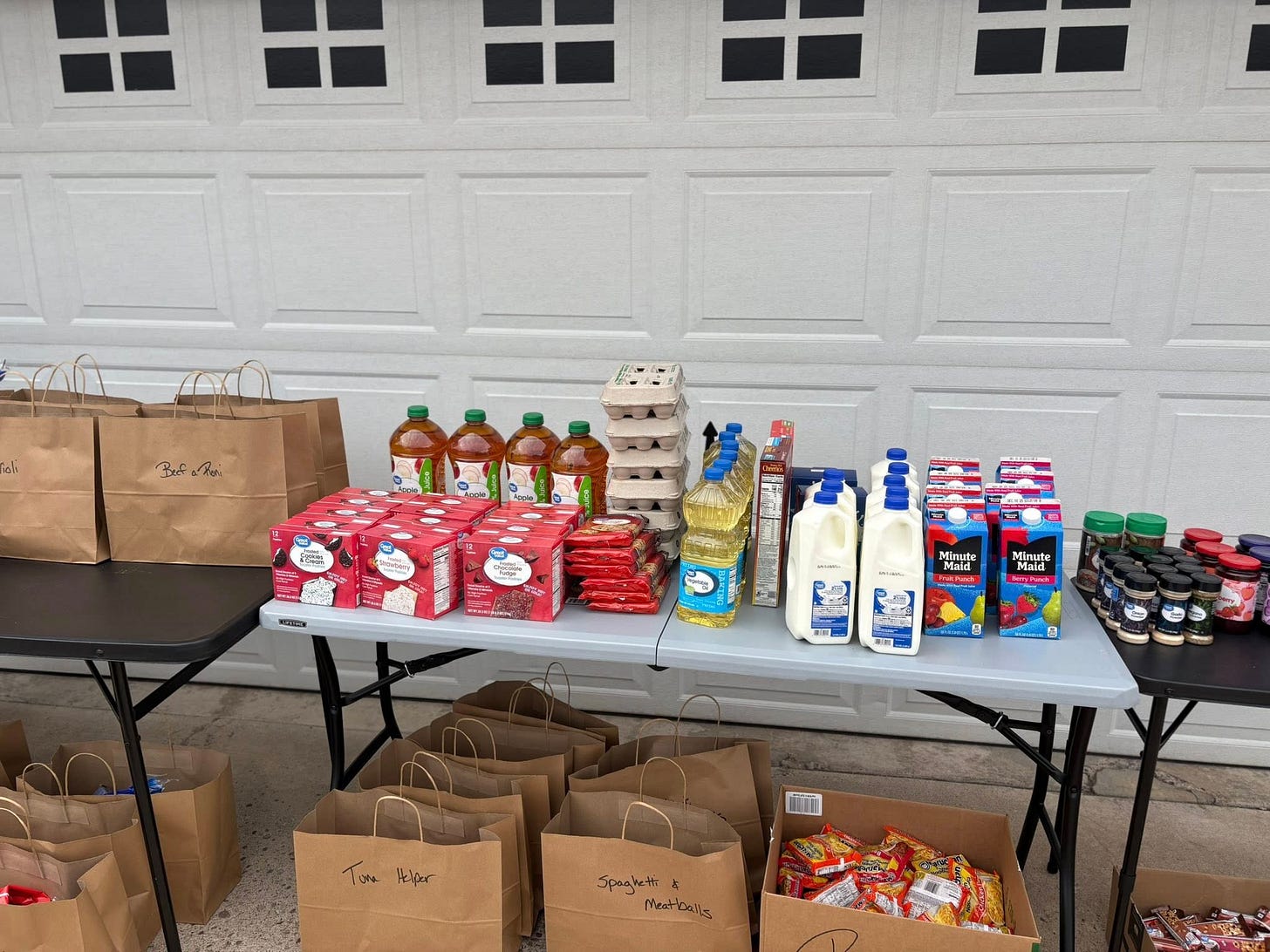What Happens When Government Stops Helping?
Mutual aid groups across the U.S. are showing us how much strength is in our communities.

The neighborhood “trial,” What was included : 5 spaghetti noodles, 5 spaghetti sauces, 5 cans of corn, 5 packets of potatoes, 5 chicken rice, 10 mini muffins, 12 packages of ramen noodles, & 12 apple sauces
What was taken between the hours of 6:45pm to 10:45pm : 2 cans of corn, 3 spaghetti sauces, 3 chicken rice, 4 mashed potato’s, 5 spaghetti noodles, 10 chocolate chip muffins, 12 apple sauces, 12 pack chicken ramen noodles, And all the candySo, so, grateful to provide for my local community
There are always more people in need than you’d suspect in your local area. Every family deserves food. Happy Halloween -Riley T
This past Friday across neighborhoods throughout America while children dressed as superheroes and princesses darted from house to house collecting candy, another kind of holiday magic unfolded on front porches and sidewalks. Parents and neighbors, many already stretched thin by rising grocery costs, set out bags filled with food and treats for families who needed them.
This is mutual aid, not charity, a community response to hunger and instability when government safety nets fail. And right now, as 42 million Americans who rely on SNAP food assistance face uncertainty during the government shutdown, understanding the difference between charity and mutual aid is incredibly important.
When the USDA Says “The Well Has Run Dry”
On November 1st, nearly 42 million Americans who rely on the Supplemental Nutrition Assistance Program (SNAP) faced the risk of losing access to their food benefits as the government shutdown entered another week. About one in eight U.S. residents, including 16 million children, receive roughly $187 a month through SNAP, a program that keeps groceries on the table for families nationwide.
While the U.S. Department of Agriculture cautioned that funding for SNAP would soon be exhausted without congressional action, social media posts summarized the moment with four haunting words: “The well has run dry.”
States scrambled to respond. Arizona, Illinois, and New York announced emergency allocations to local food banks, yet even those efforts can’t replace the roughly $8 billion in monthly federal SNAP funding. Food-aid advocates warn that if benefits lapse for long, the country could face the worst hunger crisis since the Great Depression.

I am so happy right now. I was about to go out and take a picture of my porch and say thank you to whomever gave me the idea to create bags for the adults, I was stopped short when I heard a family coming up to the door. At first the woman said they didn’t need a bag but then she took one. I can’t tell you the joy in my heart as she walked away with my little bag.
I filled it with a gift card, a travel pack of sanitary pads, some toilet paper, an add-water soup mix, and a few top ramens. It’s not much and won’t sustain them forever but I felt so good that at least one family will feel a little easier this week. ( now that I look at it, at least ten have been taken so far). There really is so much joy in giving! - Julia H
Solidarity: What Those Halloween Bags Meant
Mutual aid is a community-based system where people voluntarily share resources and support one another to meet common needs. It’s not a top-down act of generosity but a grassroots network of care and reciprocity, one that helps neighbors overcome the social, economic, and political barriers that traditional institutions too often ignore.
Here’s what makes it different from charity:
Charity: “I have, you need. Let me help you.”
Mutual aid: “We all have needs. We all can share. Let’s take care of each other.”
Charity can create a divide between those who give and those who receive, attaching conditions or oversight. Mutual aid, is rooted in solidarity, treating everyone as equals and focusing on collective community care, trust, and shared responsibility.
A common saying in mutual aid networks: “Solidarity, not charity.”
Those Halloween candy bags? They were perfect examples of mutual aid in action. No one checked income levels and no one asked for paperwork.
These are community leaders taking action, and you can too.
A Practice as Old as Survival Itself
Mutual aid is as old as humanity itself. Long before modern welfare systems, Indigenous peoples practiced collective care through kinship networks, ceremonies, and resource sharing that emphasized connection between individuals, ancestors, future generations, and the earth.
• In 1787, recently freed African Americans in Philadelphia founded the Free African Society, one of the nation’s first mutual aid organizations. Excluded from banks and public assistance, members pooled funds to buy land, support families, and care for the sick and elderly.
• In 1968, the Black Panther Party launched its Free Breakfast for Children Program. Within a year, volunteers were serving more than 20,000 children nationally by 1969. The Panthers ran under the slogan “survival pending revolution.”
• In the late 1800s, Chinese immigrants formed huiguan, mutual aid societies providing housing, jobs, and financial support while organizing against the era’s harsh anti-Chinese discrimination.
These were all communities refusing to accept that anyone among them should go without basic human needs.
SNAP benefits reduce food insecurity by roughly 30 percent and severe food insecurity by about 20 percent.
Now is the time when mutual aid steps in to fill the gaps.
The Organizers, Educators, and Movements Building This Future
For those wanting to understand how mutual aid strengthens community resilience, here are trusted educators and organizations leading the way:
🎥 Watch: “What Is Mutual Aid?” a 6-minute animated explainer by Dean Spade, author of Mutual Aid: Building Solidarity During This Crisis (and the Next). The video offers an accessible introduction to mutual aid as a strategy for grassroots resistance and collective care. Watch on YouTube.
For those wanting to dive even deeper, the Mutual Aid 101 series from Shareable includes public sessions on YouTube, plus a free Mutual Aid Toolkit covering topics from reproductive justice to disaster response.
Big Door Brigade (bigdoorbrigade.com) a comprehensive mutual aid resources and training materials
Mutual Aid Hub (mutualaidhub.org) - where you can find and connect with mutual aid networks nationwide
American Friends Service Committee (afsc.org) a step-by-step guide to creating mutual aid networks

Your Neighbor Needs Groceries and You Have a Car. This Is How Mutual Aid Starts.
The beauty of mutual aid is that it meets people where they are. You don’t need wealth, special skills, or endless free time. You just need a willingness to care for others.
If You Need Help Right Now
• Visit Mutual Aid Hub to find nearby mutual aid networks and community self-support projects or dial 211 for community resources where you can safely submit requests for groceries, rides, or other essential needs.
• Many states have launched emergency food bank funding and direct assistance programs in response to the SNAP shutdown. Contact your state Department of Human Services for the latest details on temporary food or cash-assistance programs.
• Remember: there’s no shame in needing support. Mutual aid exists because everyone needs help at some point.
If You Want to Be Part of the Solution
• Start small and local. Listen before acting and show up with empathy, acknowledge your privilege, and center the needs of those asking for help.
• Join existing efforts. Connect with local organizers and ask how to contribute instead of creating new projects right away. Many communities already have volunteer-led aid networks you can support and strengthen.
What You Can Offer
Time: deliver groceries, pick up prescriptions, or provide childcare.
Skills: translation, tech support, resume writing, or tax help.
Resources: food, winter clothing, hygiene items, or emergency supplies.
Money: direct donations to mutual aid funds, food banks, or trusted local groups.
Space: your porch for a community fridge, or your yard for a shared garden or food pantry.
Join a local mutual aid group, many operate through Facebook, Nextdoor, Discord, or other social media spaces. Volunteers are always needed to organize food drives, maintain fridges, prepare meals, or grow and share produce.
Have you ever volunteered before? How did you get involved? What tips would you share with someone who wants to join a mutual aid project or start helping in their community?

“I always start something and it becomes bigger than I anticipated. This was tonight. (Halloween) And it brought people together at least on Facebook to celebrate community service. I am going to try to organize a food drive next. What broke my heart was the lady who knocked on my door to say thank you. She cried saying she sees what people say online about SNAP. She felt cared about. It made the stress and expense completely worth it.” -Dana G
What Thanksgiving Could Mean This Year
As November begins and Thanksgiving approaches, many of us will gather around tables filled with food, expressing gratitude for what we have. Yet many of us could also be facing empty tables due to systemic breakdown and stalled federal food assistance.
Among our SNAP recipients are working families, elderly adults, veterans, people with disabilities, and millions of children. Nearly 16 million children depend on SNAP, and their access to basic nutrition became uncertain when benefits were disrupted on November 1.
Thanksgiving has always meant more than one meal on one day. It represents that no one in our communities should go hungry. The Pilgrims’ survival in 1621 depended entirely on the generosity and agricultural knowledge of the Wampanoag people, an early act of mutual aid, even if later history betrayed that initial cooperation.
This year, we can reclaim that original spirit in an authentic way:
Instead of (or in addition to) your family feast:
• Organize a neighborhood food drive for local food banks or community fridges.
• Host a Thanksgiving potluck where every dish supports a local mutual aid effort.
• Collect donations for mutual aid groups or emergency food programs during your family gathering.
• Start a giving circle where friends or coworkers commit to covering one family’s grocery needs for a month. (Consider starting with a social media group to gain traction!)
Mutual aid builds solidarity. It transforms gratitude into action by creating new communities of care, redistributing resources, and sharing skills to ensure that no one faces hunger alone.
Why Traditional Systems Can’t Save Us (But We Can Save Each Other)
In 2023, 13.5% of U.S. households, about one in seven experienced food insecurity, up from 10.5% in 2020, according to the USDA. At the same time, grocery prices continue to climb, housing costs consume larger shares of income, and millions struggle to afford healthcare. Add in climate disasters that displace families nationwide, and the safety nets that once promised security now look increasingly fragile.
Traditional institutions like government agencies, major nonprofits, and corporate philanthropies often move too slowly. They rely on applications, waiting periods, and eligibility tests that decide who is “deserving.” These systems maintain hierarchies instead of meeting immediate needs. Mutual aid doesn’t wait.
Mutual aid is a form of community organizing in which people meet each other’s needs directly, bypassing bureaucratic or hierarchical structures. It replaces extractive processes with horizontal, community-based relationships rooted in trust, care, and reciprocity.
When someone needed Halloween candy for their kids, neighbors didn’t file paperwork or apply for grants. They filled bags and set them out. When SNAP benefits disappear, communities don’t wait for Congress to act. They organize food drives, shared meals, and resource exchanges immediately.
This is how communities have always survived impossible circumstances. This is what those Halloween candy bags were really teaching us… solidarity and community keeps people fed.
What acts of mutual aid have you witnessed or participated in? Share your stories in the comments below, your experience might inspire someone else to act. :)
The Economics of Kindness: What Happens When We Help
Every month, the federal government distributes about $8 billion in Supplemental Nutrition Assistance Program (SNAP) benefits. These funds are loaded onto Electronic Benefit Transfer (EBT) cards that families use at grocery stores, farmers markets, and corner stores across the country. More than 250,000 food retailers depend on that income to keep their doors open.
When SNAP funding stops, the impact doesn’t end with hungry families. Small grocers lose business, farmers markets see fewer customers, and local economies shrink. Children struggle to focus in school, parents will end up missing work and health problems will worsen.
Every time neighbors share food, transportation, or care, we generate new capacity in our communities. A parent with groceries can show up for their kids. An elder with prescription delivery maintains health and independence. A job seeker with gas money makes it to an interview. These small exchanges create resilient local economies built on trust instead of scarcity.
After calling the local and Washington offices of my congressional representative, I donated this to the local food bank for the cost of dinner for two at a fancy restaurant.
Speak up as you are able. Give what you can afford. Keep the faith. -Tom W
*Click here to see Tom’s post*
You Already Know How To Do This
You don’t need to organize a citywide network or raise thousands of dollars.
Mutual aid can be very simple: you have something someone needs, and someone has something you need. It might be food, time, skills, or simply the willingness to see and acknowledge another person’s humanity.
No matter what the future brings, the overlapping crises we face, from economic instability and climate change to aging populations and systemic inequality, demand solidarity.
Mutual aid offers an accessible way for anyone to participate in that resistance, creating ongoing networks of community care and shared well-being that will outlast any crisis.
Start Today
• Visit Mutual Aid Hub to find local groups near you.
• Follow neighborhood or regional mutual aid pages on social media.
• Ask a neighbor, friend, family, or community member, “How can I support you?”
• Put together a bag of groceries or hygiene items for a nearby food pantry.
• Share this post with someone who wants to help or who you think would help.
The government shutdown will end, and SNAP benefits will return, but the need for community care will not. Hunger, housing insecurity, and inequality are not temporary, they require sustained, local, people-powered solutions.
Halloween mutual aid bags on porches show that we already know how to do this. We already have the instinct to care for one another. We already understand that a strong community ensures everyone has enough.
Now we scale that instinct. Extend it beyond one night, beyond one act, and build the networks that will sustain us through whatever comes next.
The well may be running dry in Washington but in neighborhoods across America, we’re filling each other’s buckets through mutual aid networks.
This work takes time, research, and heart. Every article here is independently researched, written, and fact-checked with no sponsors, no corporations, no newsroom behind it.
If this reporting helps you understand what’s happening or reminds you that change is still possible please consider supporting it.
Free subscriptions keep the conversation going.
Paid subscriptions directly fund the time, tools, and research it takes to investigate, write, and build resources like this one. Your support allows me to keep doing this work consistently and to grow it into something sustainable.
In the end, what holds us together isn’t policy or profit, it’s each other. When one person reaches out, it creates a chain reaction of courage, care, and defiance against despair. Every small act of generosity strengthens our community. Mutual aid is how we create incredible networks.
We’ve always survived by sharing: stories, food, and hope.
That’s what this moment asks of us again, to remember that resilience is collective and that even in scarcity, we have abundance when we stand together.
The buckets we fill for each other become the wells that never run dry.




If we, as a society, redefine “wealth” as not how much you have - but, as how much you can give away, the wealthiest among us will be the ones who are the most charitable. Many cultures look at wealth this way, unfortunately, not ours.
👍It's Always up to WE THE PEOPLE!